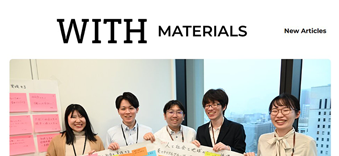- Home
- Sustainability Report
- Mitsubishi Materials Group's Initiatives on Material Issues
- Promotion of resource recycling design through advanced recycling technology
Promotion of Resource Circulation
Promotion of Resource Recycling Design through Advanced Recycling Technology
Recycling-oriented Business Model
Overview of our Recycling-oriented Business Model
The Mitsubishi Materials Group is a complex corporate entity encompassing a wide range of technologies and expertise, from resources upstream to materials midstream to processed products downstream. We have continued to make the most of those capabilities on a Group-wide scale, in an effort to establish a recycling-oriented business model based on recovering resources from a wide range of waste products.
We strive to create cyclical value chains in each of our businesses, so that resources and materials are processed into products and then recycled back into materials. This also helps to promote recycling-oriented social systems (Circular Economy).
We will achieve growth throughout the value chain to expand resource recycling. We will achieve this by leveraging our strength in advanced dismantling and separation technologies in the home appliance recycling business, along with recycling technologies in the smelting business, expanding the range of items to which these technologies are applied, the regions in which we operate, and the scale of operations.
In the recycling of metal resources, we will recover used or discarded products, disassemble or separate them, input the materials into smelting or other processes to extract useful metal elements, then process or fabricate those elements into high-performance materials and products that will be supplied to the market.
In this way, we will design and build a circulatory system for resources through “veins” that circulate resources, “arteries” that supply high-performance materials and products, and once again through “veins” via the market. At the same time, the Renewable Energy business will supply the renewable energy-based power it has generated to the entire business, contributing to progress in reducing greenhouse gases on the way to achieving carbon neutrality.
Recycling-oriented Business Model of the Group
In Pursuit of a Recycling-oriented Business Model
| Purpose of activities | Activities during FYE March 2024 | Self- assessment |
Targets/plans for activities FYE March 2025 onwards |
|---|---|---|---|
| Expand processing of recyclables (Metals business (Smelting sector)) |
Promoted the recovery of trace components in recycled raw materials | A | Strengthen and expand the scale of networks aimed at recycling resources |
| Planned construction of a recycled raw material pre-processing facility at the Onahama Smelter of Onahama Smelting & Refining Co., Ltd. | Increase the recycling rate by expanding E-Scrap processing | ||
| Create a recycling business for rare earth elements and rare metals | |||
| Aiming to be the driving force of resource-recycling systems Providing reliable recycling systems, such as by ensuring traceability (Metals business (Resource-recycling sector)) |
Released the recycled metal brand REMINE | A | Expansion of applicable products |
| Considered the commercialization of the Exurban Project, a smelting business using only E-Scrap raw materials | US-based project feasibility study, investment decision during the fiscal year ending March 2025, consideration of expansion to other regions | ||
| Considered commercialization of home appliance recycling business in Malaysia | Investment decision after enactment of legislation (expected in 2025), consideration of expansion to other regions | ||
| Considered development of a resource recycling system with users (including the recycling of materials that are difficult to process) | Establishment of implementation and management policies, expansion of applicable users | ||
| Implemented automatic dismantlement robots | Expand the home appliance recycling business, promote automation of home appliance recycling, and improve the added value of collected items | ||
| Introduced system for managing home appliance recycling operations (other site) | Expand introduction of home appliance recycling operation management system and model number recognition technologies (other sites, upstream processes) | ||
| Demonstrated next-generation automobile recycling technologies (motors, LIB) | Demonstrate HV motor recycling technologies and LIB recycling technologies | ||
| Continue to consider PV recycling system | Commercialization of solar panel recycling system | ||
| Promoting the recycling of fluorine resources (Advanced Products business (Electronic Materials & Components)) |
The amount recycled was 1,402 tons/year, 7% below the budget | B | Ensure the stable operation of recycling plants and achieve the plan of the amount recycled |
| The raw material recycling rate was 14% | |||
| Promoting the recycling of tungsten (Metalworking Solutions business) |
Recycling rate increased (by 188% from the fiscal year ended March 2018 level) | A | Increase the recycling rate (by 192% from the fiscal year ended March 2018 level) |
| Increased recycling collections | Expand amount of materials recovered for recycling (expand overseas recovery area) |
Self-assessment grades A: Target achieved B: Target mostly achieved C: Target not achieved
Recycling in Individual Businesses
Metals Business
Recycling Rare Metals
PGM* are rare metals that are found in E-Scrap, etc. Group company Materials Eco-Refining Co., Ltd. refines PGM intermediate materials obtained from our Naoshima Smelter & Refinery, to create products such as metals and chemical compounds.
Platinum and palladium in particular are key materials in the automotive, electric and electronic sectors. With that in mind, we applied to register our brand with the London Platinum and Palladium Market (LPPM), as a means of ensuring credibility in the market, and successfully obtained certification in September 2012. We are determined to keep on improving the quality of our products, and make every effort to ensure stable supplies of rare metals.
- * Platinum Group Metals

Recycling Scrap
We use smelting technology for the purpose of recycling at our smelters and refineries. We take in a wide variety of scrap, including shredder dust and used batteries from sources such as used home appliances or scrap vehicles, and E-Scrap from sources such as used substrates and connectors. We then recycle scrap, by using it for raw materials or thermal energy, and recover valuable metals.

Home Appliances Recycling
Home appliances are made by combinations of various materials such as glass, plastic and rubber as well as metals such as steel, aluminum, and copper. Home appliances are first of all disassembled manually, then crushed and sorted at our home appliances recycling plants*1, which are operated in partnership with home appliance manufacturers. We have adopted several advanced sorting processes for components and materials, and are always trying to create more value from recovered materials and to improve recycling efficiency. We recover copper and other precious metals from recovered copper-based materials and printed circuit boards in our copper smelting process. Thus, we maximize the effect of synergies within our Group. In the fiscal year ended March 2024, we recycled 2,660 thousand units of home appliances at six plants of our five affiliated companies (6 companies, 7 plants, 3,514 thousand units). Recycling of this volume could reduce landfill disposal equivalent to 121 thousand tons.*2
- * This data is only available in Japanese on the website.

- *1 Major partners: Hitachi, Ltd., Sharp Corporation, Panasonic Corporation
- *2 The home appliance recycling plants subject to LCA evaluation are as follows.
・Hokkaido Eco Recycle Systems Co., Ltd.
・East Japan Recycling Systems Corp.
・Kansai Recycling Systems Co., Ltd. Main Plant, Second Plant
・Panasonic Eco Technology Kanto Co., Ltd.
・Chubu Eco Technology Co., Ltd.
- Supply of Japan's First Recycled Metal Brand "REMINE" Series Products
- The recycled content is calculated in accordance with the international standard ISO14021*1 -
We launched "REMINE," the first recycled metal brand in Japan*2, which specifies the recycled content in non-ferrous metal products. In January 2024, we began selling "Refined Tin (Ingot)" with 100% recycled content and "Refined Lead (Ingot)" with greater than 99.6% recycled content. In December 2024, we added "Refined bismuth (Bi)(Ingot)" which contains 92.2% or more recycled content, 100% "platinum (Pt) sponge," "palladium (Pd) powder" and "tungsten trioxide (WO3-5).”
REMINE is a coined word combining "RE" meaning "repeat/reborn" and "MINE." With the aim of realizing a sustainable society, we will contribute to resource recycling and environmental impact reduction by recycling metals collected in the supply chain. In order to realize a sustainable society, it is our responsibility to our stakeholders to ensure the transparency and traceability of raw materials and other information in our products in the supply chain from the perspective of resource circulation and environmental impact reduction. Additionally, the need to quantify the environmental impact of products is becoming more important.
The "REMINE" series offers non-ferrous metal products by using our cultivated strength in recycling technology. The recycled content is calculated in accordance with the international standard ISO14021 (JIS Q14021*3) and verified by a third-party organization (SGS Japan Inc.) to ensure a higher level of reliability.
Detailed product information can be found on the dedicated website below.
MMC Group will contribute to the creation of a sustainable society through the supply of "REMINE" series products.
- *1 ISO14021 is an international standard that requires the elimination of ambiguous expressions and the disclosure of information necessary for verification regarding environmental information on products. This standard includes a definition of recycled materials and a method for calculating recycled content.
- *2 This is the first time in Japan that the recycled content of non-ferrous metals is calculated in accordance with ISO14021 and verified by a third party. As of December 2023, based on our company's research.
- *3 JIS Q14021 is a Japanese industrial standard based on ISO14021 and has the common content with the international standard ISO14021.
Advanced Products Business (Electronic Materials & Components)
Recycling Fluorine Resources
We manufacture a range of fluorine compounds at the Group company Mitsubishi Materials Electronic Chemicals Co., Ltd., including materials for use in semiconductor manufacturing, flame retardant and antistatic materials, and hydrofluoric acid.
Since the fiscal year ended March 2007, we have been engaged in the recycling of fluorine resources in which we recover calcium fluoride waste emitted by companies using fluorine compounds and recycle it back into fluorine resources that can be used as alternative raw materials for fluorite. We will promote the recycling of fluorine resources through further technical innovation.
Metalworking Solutions Business
Recycling Tungsten
Waste containing rare metals contains such a high percentage of rare metals that it is possible to extract them more efficiently than obtaining metals from natural resources. A prime example is tungsten, the main raw material used in cemented carbide products. Making the most of the Mitsubishi Materials Group’s comprehensive capabilities as a manufacturer, from raw materials through to finished products, we are currently focusing on recycling used cemented carbide products in an effort to secure stable supplies of raw materials.
Affiliated Business
Recycling Industrial Waste and Byproducts
Using a burning process that reaches temperatures of 1,450°C, the Group's cement plants detoxify and make effective use of industrial waste and other difficult-to-treat materials without generating any secondary waste. As well as using substances such as coal ash, construction sludge, sludge, incineration fly ash, copper slag byproducts from copper smelters, and gypsum as the raw materials of cement, we also turn materials such as waste plastics, waste tires and wood waste back into cement, by using them as a source of thermal energy.








